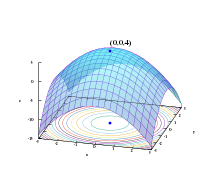Berndt–Hall–Hall–Hausman algorithm
The Berndt–Hall–Hall–Hausman (BHHH) algorithm is a numerical optimization algorithm similar to the Gauss–Newton algorithm. It is named after the four originators: Ernst R. Berndt, B. Hall, Robert Hall, and Jerry Hausman.[1]
Usage
If a nonlinear model is fitted to the data one often needs to estimate coefficients through optimization. A number of optimisation algorithms have the following general structure. Suppose that the function to be optimized is Q(β). Then the algorithms are iterative, defining a sequence of approximations, βk given by
- ,
where is the parameter estimate at step k, and is a parameter (called step size) which partly determines the particular algorithm. For the BHHH algorithm λk is determined by calculations within a given iterative step, involving a line-search until a point βk+1 is found satisfying certain criteria. In addition, for the BHHH algorithm, Q has the form
and A is calculated using
In other cases, e.g. Newton–Raphson, can have other forms. The BHHH algorithm has the advantage that, if certain conditions apply, convergence of the iterative procedure is guaranteed.
See also
References
- ↑ Berndt, E.; Hall, B.; Hall, R.; Hausman, J. (1974). "Estimation and Inference in Nonlinear Structural Models" (PDF). Annals of Economic and Social Measurement. 3 (4): 653–665.
Further reading
- Gill, P.; Murray, W.; Wright, M. (1981). Practical Optimization. London: Harcourt Brace.
- Harvey, A. C. (1990). The Econometric Analysis of Time Series (Second ed.). Cambridge: MIT Press. pp. 137–138. ISBN 0-262-08189-X.
- Luenberger, D. (1972). Introduction to Linear and Nonlinear Programming. Reading, Massachusetts: Addison Wesley.
- Sokolov, S. N.; Silin, I. N. (1962). "Determination of the coordinates of the minima of functionals by the linearization method". Joint Institute for Nuclear Research preprint D-810, Dubna.
